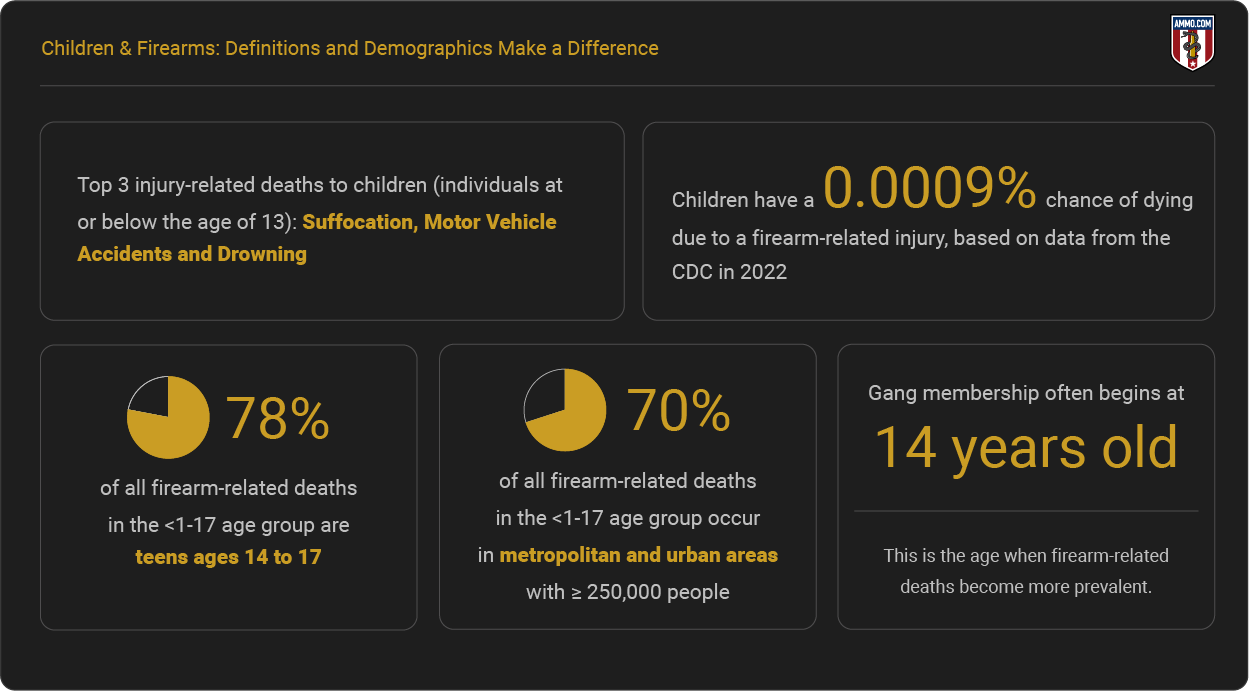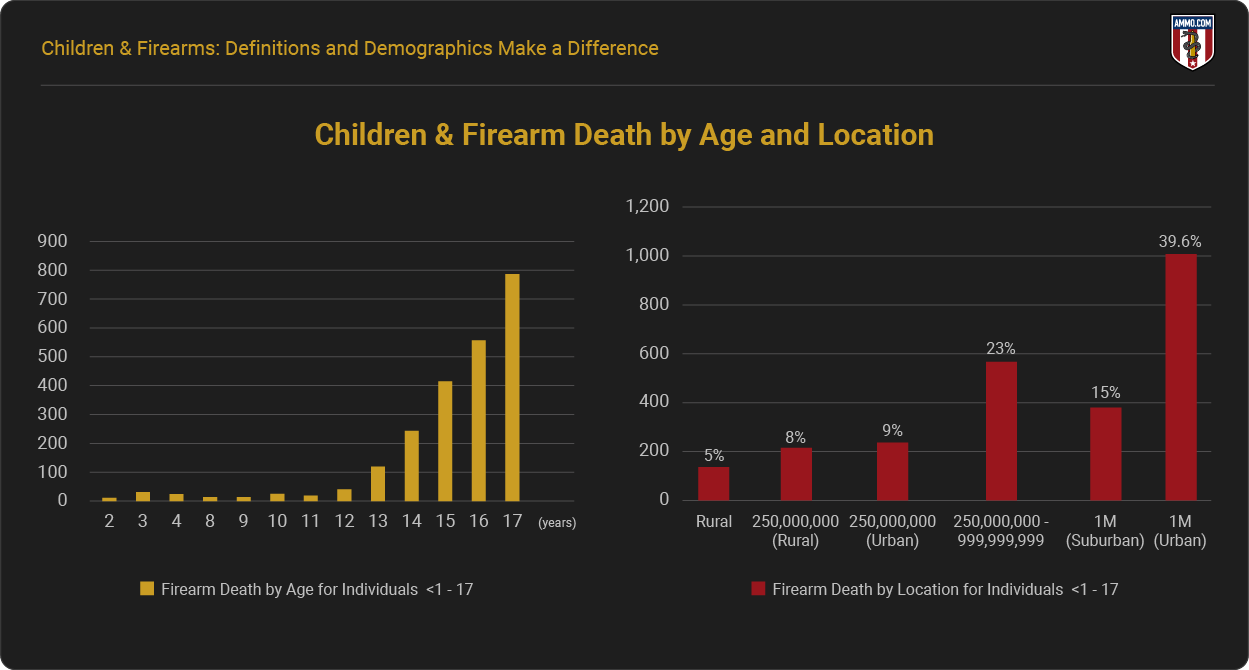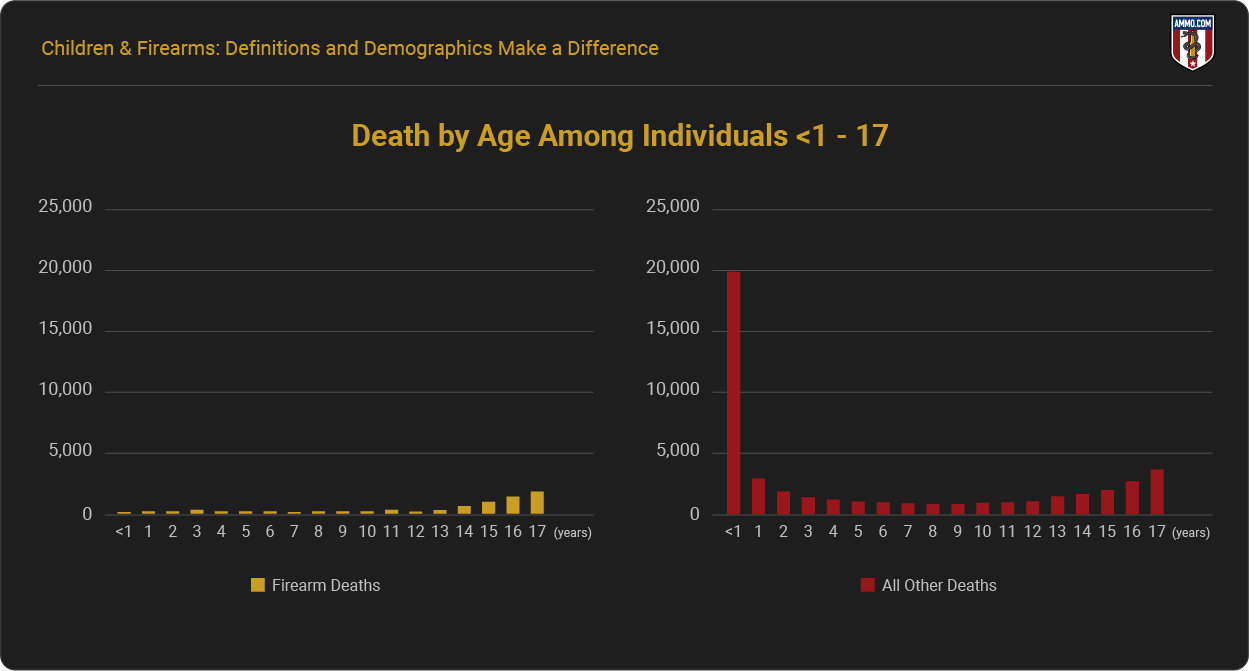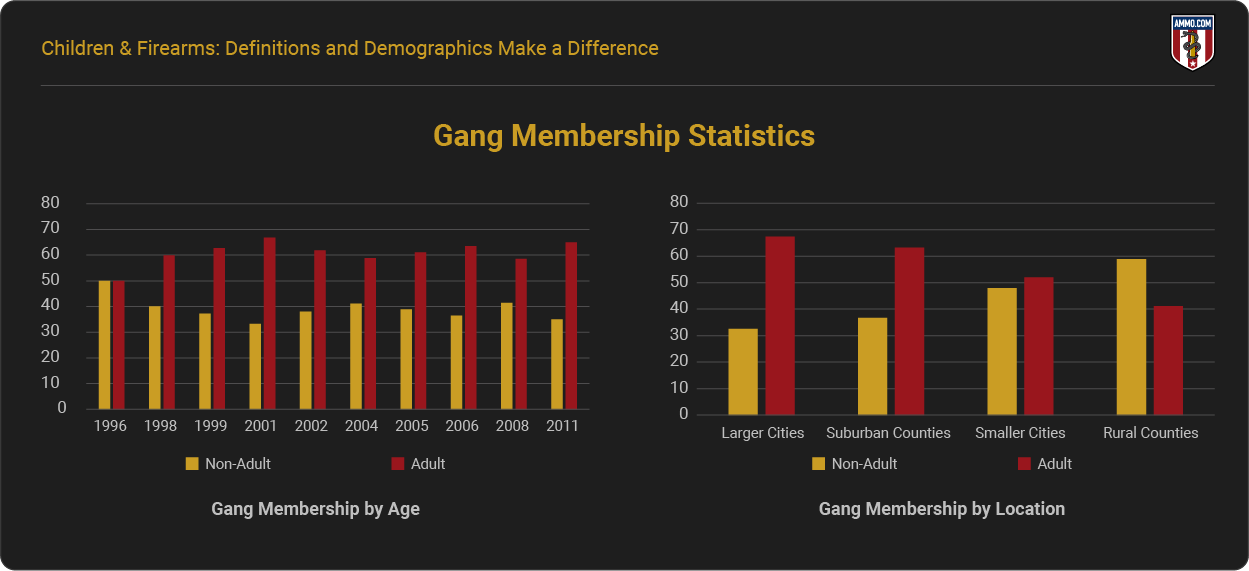Children & Firearms: Definitions and Demographics Make All the Difference
We’ve all read the headlines, “Guns are the number one killer of kids in America.” Unfortunately, that headline is grossly misleading.
To better understand children and firearms, we must first understand the definitions of adolescents and exactly what gun violence is. Looking at data with clearly defined terminology is the first step to having an effective conversation on this topic — otherwise, we will never get to the root of the problem.
Our research focuses on children and adolescents <1-17 to paint a clearer picture of adolescents and guns in the U.S.
Children, as defined, are individuals at or below the age of 13, and, therefore, the top three causes of injury-related deaths in children are suffocation, motor vehicle accidents, and drowning.
Children have a 0.0009% chance of dying due to a firearm-related injury based on data from the CDC in 2022.
Teens ages 14 to 17 comprise 78% of all firearm-related deaths in the <1-17 age group.
70% of all firearm-related deaths in the <1-17 age group occur in metropolitan and urban areas with more than 250,000 people.
Gang membership often begins at 14 years of age, and this is the age when firearm-related deaths become more prevalent.
It’s our goal to be as transparent as possible while conveying data related to this topic. The difference between a child and an adolescent is marked by puberty, environmental factors, and independence.
The transition from childhood to adulthood is marked by “rapid physical, cognitive, and psychosocial growth” according to the World Health Organization. This has significant impacts on their emotional state, how they make decisions and interact with their environment.
According to the CDC, puberty typically occurs between the ages of 12 - 14.
It should be emphasized that it is illegal for an individual <1-17 to possess a handgun in 49 states; however, 30 states allow minors to possess long guns for hunting and recreational activities with parental consent.
You can see a comprehensive list of our sources here.

Are firearms the leading cause of death for children?
No, firearms are not the leading cause of death for children. Rather, it is the leading cause of death for adolescents in urban centers with a high prevalence of gang membership.
Many studies on adolescents and gun violence include individuals who are between 18 and 19 years old. Others include individuals up to age 24. Unfortunately, this adds a layer of complexity to the topic of gun violence and children.
Nuanced terminology skews the data and distracts conversations away from root problems.
Children, Firearms, and Urbanization

Firearm deaths are not something that affects children nationwide. Rather, firearm-related deaths are concentrated in urban areas. 70% of all adolescent firearm deaths occur in areas with more than 250,000 people (including suburban areas with large populations).
Zooming in even further, urban areas are the most dangerous for adolescents aged <1-17. In fact, urban areas account for 40% of all adolescent firearm deaths.
The second most dangerous places for children and teens are medium populations or urban areas with between 250,000 and 999,999 people. Rural and suburban areas (including those with 1,000,000+ people) account for the least amount of firearm-related deaths in the <1-17 year age group.
Death by Age

Just as firearm deaths disproportionately impact children and adolescents living in urban areas, age also plays a role. 78% of all firearm-related deaths in 2022 were individuals between 14 and 17 years old.
Over half (53%) of all firearm-related deaths in the <1-17 age group are older teens (16 and 17-year-olds).
We can further explore how urban centers disproportionately affect 17-year-olds. Whereas 17-year-olds comprise 30% of all firearm deaths in the adolescent age group. 24% of those deaths occurred in urban areas with large population sizes.
Therefore, children, as defined above, are the least likely to be killed with a firearm. Instead, suffocation is the number one injury-related cause of death for children, with motor vehicle accidents being number two, and drowning being the third leading cause.
Guns, Gangs, & Teens
Another aspect worth noting is that gang membership often begins at the age of 14. This age is also when firearm-related deaths become more prevalent in urbanized areas.
Recent estimates indicate that gang membership is more prevalent in urban and suburban settings. Furthermore, between 35% and 41% of gangs in large-population areas comprise individuals under the age of 18.
When we compile all of these facts, we can see a positive correlation between gang membership and firearm-related deaths among children and adolescents.
Moreover, while youth gang membership tends to be higher in rural areas, those areas also have fewer issues with gang violence and criminality. This leads us to believe that adult involvement in gang membership leads to a higher risk of firearm-related deaths.

Breakdown of Firearm Deaths and Young People
Children have a 0.0009% chance of dying due to a firearm-related injury based on data from the CDC in 2022. In fact, children are the least likely demographic to die from firearms.
As individuals reach puberty and gain more independence, the chances of firearm-related deaths rise sharply to 0.01%. However, even these deaths are marked by gang membership and urbanization.
Individuals aged 14-17 in urban areas (large and medium metros) are at the highest risk of gun-related deaths (0.07% in 2022), while those in large suburban areas (population over 1,000,000) are far less likely to die from firearms (0.002%).
Ultimately, there is something going on with adolescents in urban centers. Those in large suburban areas, small cities, and rural populations, regardless of age, are far less likely to die from firearms than their inner-city peers.
Furthermore, firearms are not the leading cause of death for children. Rather, it is the leading cause of death for adolescents in urban centers with a high prevalence of gang membership.
Assessing the Nature of Children & Firearm-Related Deaths
Firearm-related deaths among children are pretty low and certainly lower than many other injury-related causes.
However, when we factor in gang violence and post-pubescence with higher population densities, firearm-related deaths rise sharply. The leading cause of death for children is not guns.
Children are not at an extreme risk of death due to firearms. Despite the claims of the media and politicians, children are less likely to be victims of bullets than suffocation, traffic accidents, and drowning.
Furthermore, focusing on children rather than teens in urban populaces derails the conversation from where it is needed. We should be asking why adolescents in large suburbs and rural areas are safer than those in areas with gangs and denser population.
Sources
- CDC WISQARS
- K-12 Shooting Database
- Education Week
- Averted School Violence
- Education Week (2021 School Shootings)
- KFF States with Safe Gun Storage Requirements
- CrimeResearch.org
- Associated Press
- Office of Juvenile Justices
- Education Commission
- CDC Firearms Homicide 2021
- CHDS School Shooting Methodology
- CDC Wonder Vehicle-Related Deaths
- KFF foundation Adolescent Suicides
- Assault Weapons Ban Study
- World Health Organization
Infographics
- Are Guns & Ammo The New Gold? Why More Americans Are Arming Themselves
- The Greatest Gun Salesman In America: President Barack Obama
- Shooting Straight: How Both Presidential Candidates Have Changed On Gun Control
- President Obama: (Still) The Greatest Gun Salesman in America
- An Inconvenient Truth: How The Obama Administration Became Earth's Largest Arms Dealer
- Armed Drones: President Obama's Weapon of Choice
- COVID-19 Data Study: Ammunition Sales Continue to Soar in Response to Coronavirus Panic
- Data Study: 18 Months of Ammo Sales during a Pandemic, Protests, and the Biden Presidency
- Data Study: U.S. Ammo Sales Surge Following Russian Invasion of Ukraine
- Most Gun-Friendly States in 2024
- Worst States to be a Gun Owner (2024 Updated)
- Children & Firearms: Definitions and Demographics Make All the Difference
- Urban Violent Crime & Legal Gun Ownership
- Gun-Free School Zone Laws & School Shootings (2024 Updated)
- Gun Control Laws and Enforcement Trends 2024
- Gun Ownership by State (2024 Statistics)
- How Many Gun Owners are in America? (2024 Statistics)
- Concealed Carry Crime Stats 2024
- Accidental Shooting Statistics: A Review of Unintentional Firearm Deaths from 1979-2024
- America’s Stolen Guns: A Silent Contributor to Gun Crimes in the U.S. (2024)
- Gun Violence Statistics 2024: Comprehensive Look at the Data
- Gun Laws vs. Crime Rates in 2024: A Comprehensive Analysis
- Gun Death Statistics by Caliber: A Review of Calibers and Crime in 2024
- Anti-Gun Control Arguments 2024: Facts Gun Control Lobby Suppress
- Guns in the Home Statistics: The Effects of Firearms in the Home in 2024
- Gun Deaths in the US: Analyzing At-Risk Demographics in 2024
- How Many Guns in the U.S.: All About America’s Firearms in 2024
- Gun Facts in the U.S. 2024: The Reality of Firearms in America
- Defensive Gun Use Statistics: America’s Life-Saving Gun Incidents (2024)
- Correlation Between Mass Shootings and Prescription Drugs (2024 Study)
- Gun Ownership by Gender in 2024: Closing the Gender Gap
- Murders by Weapon Type: September 2024 Statistics
- Gun Violence Among Black Americans: September 2024 Statistics
- The Ultimate Hunting Caliber Chart: Best Cartridge Per Species
- How Old Do You Have to be to Buy a Gun: A State Guide 2024
- Most Popular Guns in the U.S.: The Must-Have Guns in 2024
- Stray Bullet Deaths: Accident and Injury Statistics in September 2024
- Mass Shooters by Race: Demographics of Assailants 1966-2024
- Ammunition Limits By State in 2024: How Much Ammo Can You Buy?
- Why Do Americans Own Guns in 2024?
- How Many Americans Want Stricter Gun Laws in 2024?
- How Many Households in the U.S. Have a Gun in 2024?
- What Percentage of Gun Deaths are Suicides in 2024?
- Average Age of Mass Shooters in the U.S.
- Firearm Ownership in America by Year
- US Firearms Deaths Per Year: A Collective Report 1968-2024
- Percentage of Americans Owning Guns in 2024
- Texas Gun Ownership: Total Numbers, Trends, and Most Popular Guns
- Gun Ownership Statistics Colorado 2025: Trends & Numbers
- Hunting Accident Statistics 2025 (Causes & Trends Per Year)
- Banned Guns & Ammo List: A 2025 Review by State
- 3D Printed Gun Laws By State
- How To Build a Home Shooting Range: The Ultimate Guide
- States With the Highest Murder Rates
